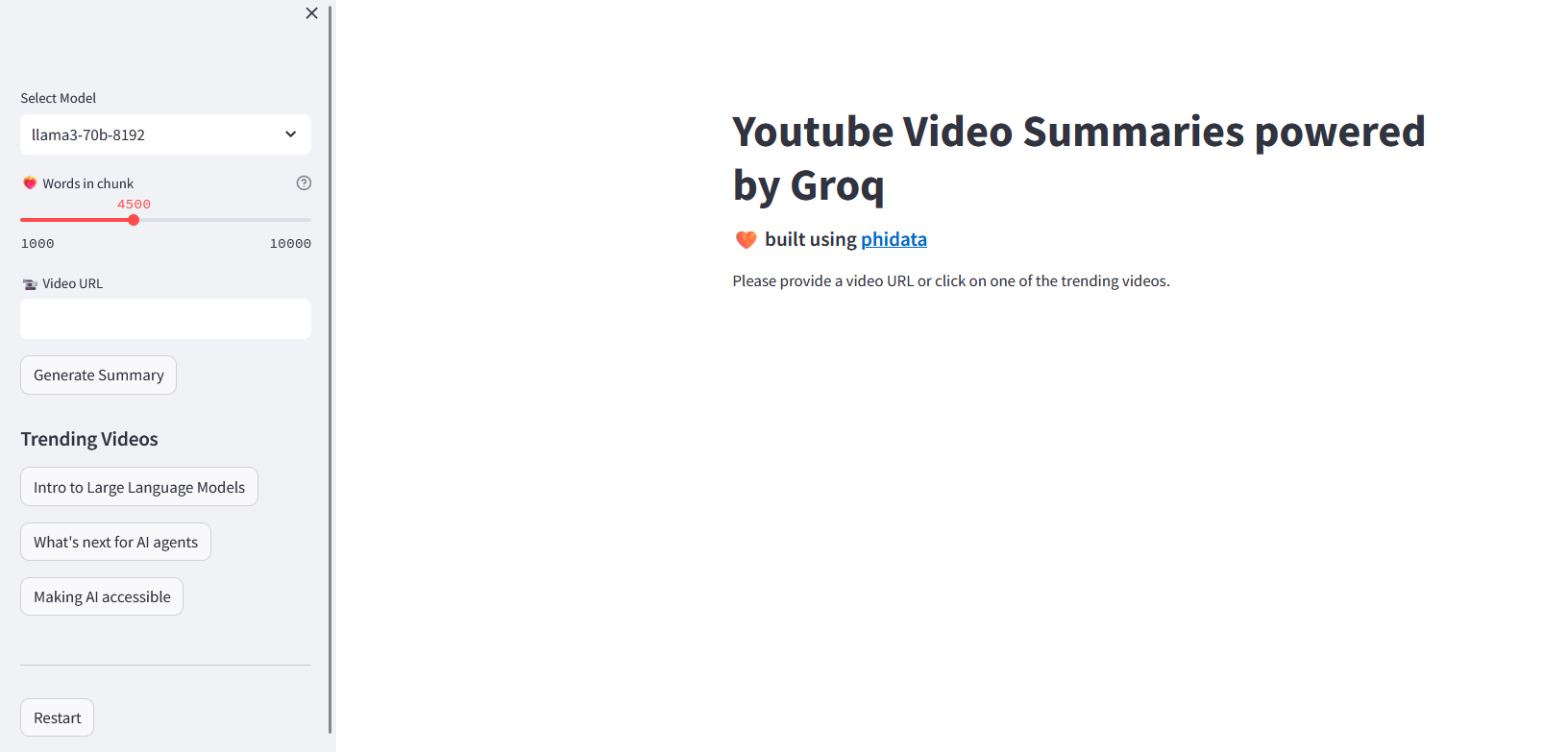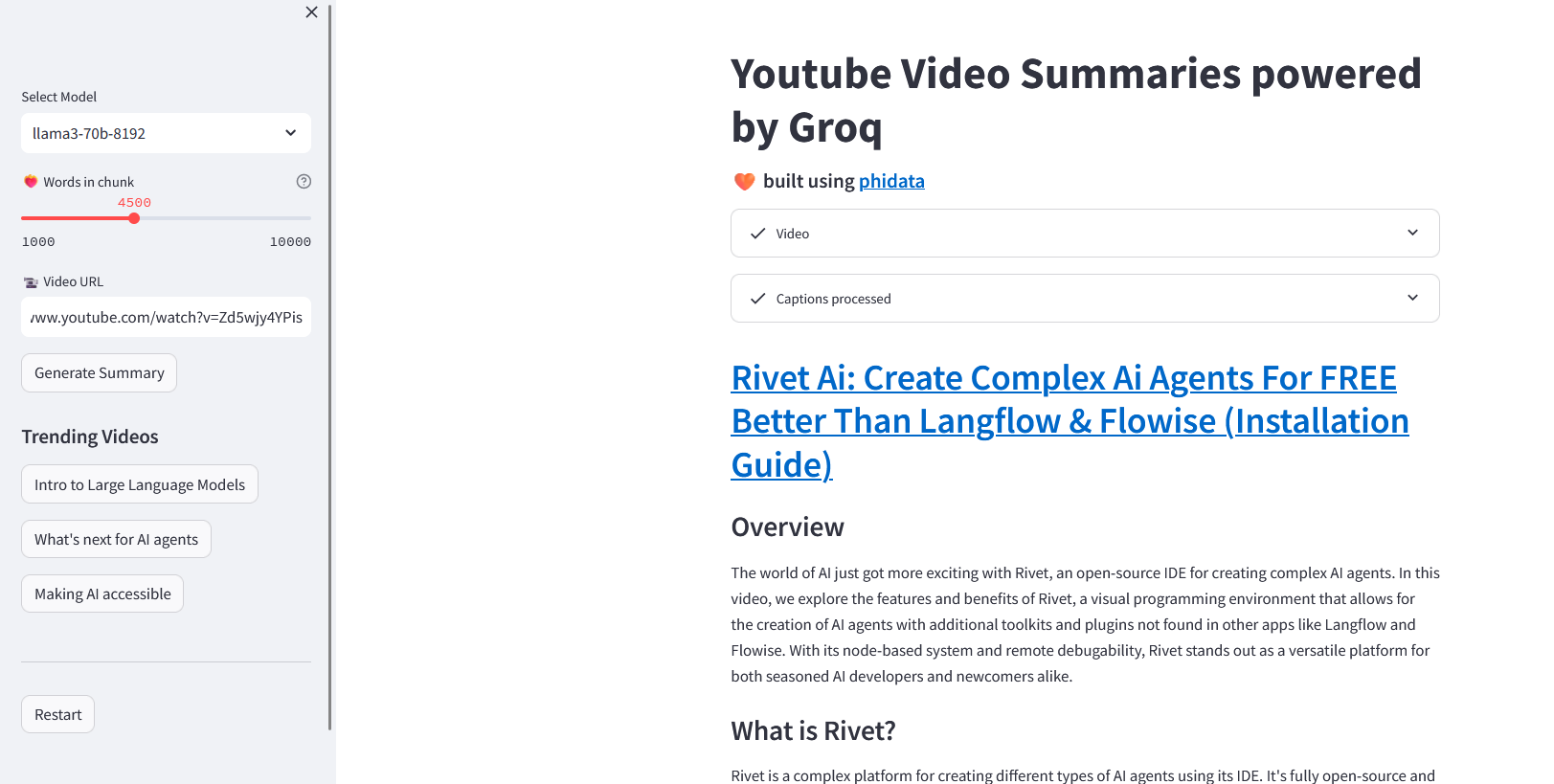The API offered by ‘Groq, Inc.’ for their Language Processing Unit (LPU) hardware - AI hardware specifically designed to accelerate performance for natural language processing (NLP) tasks.
Thanks to the Groq LPU API we have a programmatic way for developers to interact with the LPU and leverage its capabilities for their applications.
- The PhiData Project is available on GitHub
- Project Source Code at GitHub
- It is Licensed under the Mozilla Public License v2 ✅
- Project Source Code at GitHub
Build AI Assistants with memory, knowledge and tools.
Today, we are going to use Groq API with F/OSS Models to…chat with a Youtube video.
| Information | Details |
|---|---|
| API Key from Groq | You will need an API key from Groq to use the project. |
| Model Control | The models might be open, but you won’t have full local control over them - send queries to a 3rd party. ❎ |
| Get API Keys | Get the Groq API Keys |
| LLMs | The LLMs that we will run are open sourced ✅ |
This is what we will get:

And there are many more interesting projects in their repository!
SelfHosting Groq Video Summaries
The phi-data repository contains several sample applications like this one, but our focus today will be at: phidata/cookbook/llms/groq/video_summary
It is very simple to get Youtube video summaries with Groq, we are going to do it systematically with Docker.
Really, Just Get Docker 🐋👇
You can install Docker for any PC, Mac, or Linux at home or in any cloud provider that you wish. It will just take a few moments. If you are on Linux, just:
apt-get update && sudo apt-get upgrade && curl -fsSL https://get.docker.com -o get-docker.sh
sh get-docker.sh
#sudo apt install docker-compose -yAnd install also Docker-compose with:
apt install docker-compose -yWhen the process finishes, you can use it to self-host other services as well. You should see the versions with:
docker --version
docker-compose --version
#sudo systemctl status docker #and the statusWe will use this Dockerfile to capture the App we are interested from the repository and bundle it:
FROM python:3.11
# Install git
RUN apt-get update && apt-get install -y git
# Set up the working directory
#WORKDIR /app
# Clone the repository
RUN git clone --depth=1 https://github.com/phidatahq/phidata && \
cd phidata && \
git sparse-checkout init && \
git sparse-checkout set cookbook/llms/groq/video_summary && \
git pull origin main
WORKDIR /phidata
# Install Python requirements
RUN pip install -r /phidata/cookbook/llms/groq/video_summary/requirements.txt
#RUN sed -i 's/numpy==1\.26\.4/numpy==1.24.4/; s/pandas==2\.2\.2/pandas==2.0.2/' requirements.txt
# Set the entrypoint to a bash shell
CMD ["/bin/bash"]
And now we just have to build our Docker Image with the Groq Youtube Summarizer App:
docker build -t phidata_yt_groq .
sudo docker-compose up -d
#docker-compose -f phidata_yt_groq_Docker-compose.yml up -d
docker exec -it phidata_yt_groq /bin/bash
Now, you are inside the built container.
Just execute the Streamlit app to test it:
#docker or podman run
docker run -d --name=phidata_yt_groq -p 8502:8501 -e GROQ_API_KEY=your_api_key_here \
phidata:yt_summary_groq streamlit run cookbook/llms/groq/video_summary/app.py
# podman run -d --name=phidata_yt_groq -p 8502:8501 -e GROQ_API_KEY=your_api_key_here \
# phidata:yt_summary_groq tail -f /dev/null
How to use Github Actions to build a multi-arch Container Image ⏬
If you are familiar with github actions, you will need the following workflow:
name: CI/CD Build MultiArch
on:
push:
branches:
- main
jobs:
build-and-push:
runs-on: ubuntu-latest
steps:
- name: Checkout repository
uses: actions/checkout@v2
- name: Set up QEMU
uses: docker/setup-qemu-action@v1
- name: Set up Docker Buildx
uses: docker/setup-buildx-action@v1
- name: Login to GitHub Container Registry
uses: docker/login-action@v1
with:
registry: ghcr.io
username: ${{ github.actor }}
password: ${{ secrets.CICD_TOKEN_YTGroq }}
- name: Set lowercase owner name
run: |
echo "OWNER_LC=${OWNER,,}" >> $GITHUB_ENV
env:
OWNER: '${{ github.repository_owner }}'
- name: Build and push Docker image
uses: docker/build-push-action@v2
with:
context: .
push: true
platforms: linux/amd64,linux/arm64
tags: |
ghcr.io/${{ env.OWNER_LC }}/phidata:yt-groq
It uses QEMU together with docker buildx command to build x86 and ARM64 container images for you.
And once you are done, deploy it as a Docker Compose Stack:
version: '3.8'
services:
phidata_service:
image: phidata_yt_groq #ghcr.io/jalcocert/phidata:yt-groq
container_name: phidata_yt_groq
ports:
- "8501:8501"
environment:
- GROQ_API_KEY=your_api_key_here #your_api_key_here 😝
command: streamlit run cookbook/llms/groq/video_summary/app.py
#command: tail -f /dev/null # Keep the container running
# networks:
# - cloudflare_tunnel
# - nginx_default
# networks:
# cloudflare_tunnel:
# external: true
# nginx_default:
# external: true
For Production deployment, you can use NGINX or Cloudflare Tunnels to get HTTPs
How to SelfHost the Streamlit AI App with Cloudflare ⏬
- Visit -
https://one.dash.cloudflare.com - Hit Tunnels (Network section)
- Create a new Tunnel

And make sure to place the name of the container and its internal port:

Conclusion
Now we have our Streamlit UI at: localhost:8501
Feel free to ask for Summaries about Youtube Videos with Groq:

Similar AI Projects 👇
- Using PrivateGPT to Chat with your Docs Locally ✅
- Using Streamlit + OpenAI API to chat with your PDF Docs
Groq vs Others
| Service | Description |
|---|---|
| Ollama | A free and open-source AI service that features local models, allowing users to host their own machine learning models. Ideal for users who prefer to keep data on their own servers. |
| Text Generation Web UI | A free and open-source AI service using local models to generate text. Great for content creators and writers needing quick text generation. |
| Mistral | AI service specializing in creating personalized user experiences using machine learning algorithms to understand behavior and preferences. |
| Grok (Twitter) | AI service by Twitter for data analysis and pattern recognition, primarily used for analyzing social media data to gain insights into user behavior. |
| Gemini (Google) | Google’s AI service providing APIs for machine learning and data analysis. |
| Vertex AI (Google) | Google’s AI service offering tools for data scientists and developers to build, deploy, and scale AI models. |
| AWS Bedrock | Amazon’s foundational system for AI and ML services, offering a wide range of tools for building, training, and deploying machine learning models. |
| Anthropic (Claude) | Research-oriented AI service by Anthropic, aiming to build models that respect human values. Access their API and manage your keys in their console. |
| API, Console |
Adding Simple Streamlit Auth
We can use this simple package: https://pypi.org/project/streamlit-authenticator/
A secure authentication module to validate user credentials in a Streamlit application.
import streamlit as st
from Z_Functions import Auth_functions as af
def main():
if af.login():
# Streamlit UI setup
st.title("Portfolio Dividend Visualization")
if __name__ == "__main__":
main()
It is a referencing a Auth_functions.py in another file:
Define Auth_functions.py in a separate file with ⏬
import streamlit_authenticator as stauth
# Authentication function #https://github.com/naashonomics/pandas_templates/blob/master/login.py
def login():
names = ['User Nick 1 🐷', 'User Nick 2']
usernames = ['User 1', 'User 2']
passwords = ['SomePassForUser1', 'anotherpassword']
hashed_passwords = stauth.Hasher(passwords).generate()
authenticator = stauth.Authenticate(names, usernames, hashed_passwords,
'some_cookie_name', 'some_signature_key', cookie_expiry_days=1)
name, authentication_status, username = authenticator.login('Login', 'main')
if authentication_status:
authenticator.logout('Logout', 'main')
st.write(f'Welcome *{name}*')
return True
elif authentication_status == False:
st.error('Username/password is incorrect')
elif authentication_status == None:
st.warning('Please enter your username (🐷) and password (💰)')
return False
FAQ
| What’s Trending Now? | Description |
|---|---|
| Toolify | A platform that showcases the latest AI tools and technologies, helping users discover trending AI solutions. |
| Future Tools | A website dedicated to featuring the most cutting-edge and trending tools in the tech and AI industry. |
How to use Groq API Step by Step with Python ⏬
Thanks to TirendazAcademy, we have a step by step guide to know how to make queries to Groq API via Python:
- https://github.com/TirendazAcademy/LangChain-Tutorials/blob/main/Groq-Api-Tutorial.ipynb - We can even use Google Colab!
!pip install -q -U langchain==0.2.6 langchain_core==0.2.10 langchain_groq==0.1.5 gradio==4.37.1
from google.colab import userdata
groq_api_key = 'your_groq_API'
from langchain_groq import ChatGroq
chat = ChatGroq(
api_key = groq_api_key,
model_name = "mixtral-8x7b-32768"
)
from langchain_core.prompts import ChatPromptTemplate
system = "You are a helpful assistant."
human = "{text}"
prompt = ChatPromptTemplate.from_messages(
[
("system", system), ("human", human)
]
)
from langchain_core.output_parsers import StrOutputParser
chain = prompt | chat | StrOutputParser()
chain.invoke(
{"text":"Why is the sky blue?"}
)
Ways to Secure a Streamlit App
We have already seen a simple way with the Streamlit Auth Package.
But what if we need something more robust?
How to secure the Access for your AI Apps
- F/OSS Apps to manage Application access Management:
- Authentik
- LogTo:
| Interesting LogTo Resources | Link |
|---|---|
| Protected App Recipe | Documentation |
| Manage Users (Admin Console) Recipe | Documentation |
| Webhooks Recipe | Documentation –> Webhooks URL |
Social sign-in experience with Logto
-
Authenticate Users via Email: Easily authenticate users through email.
-
Create a Protected App: Add authentication with simplicity and speed.
- Protected App securely maintains user sessions and proxies your app requests.
- Powered by Cloudflare Workers, enjoy top-tier performance and 0ms cold start worldwide.
- Protected App Documentation
-
Video Tutorial: Learn how to build your app’s authentication in clicks, no code required.
How to install AI easily
Some F/OSS Projects to help us get started with AI:
AI Browser - MIT ❤️ Licensed!
And if you need, these are some FREE Vector Stores for AI Projects
| Project/Tool | Link |
|---|---|
| Vector Admin Project | Self-Hosting Vector Admin with Docker |
| FOSS Vector DBs for AI Projects | Self-Hosting Vector Admin with Docker |
| ChromaDB | Self-Hosting ChromaDB with Docker |